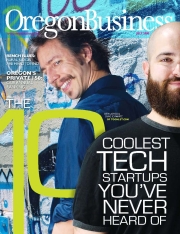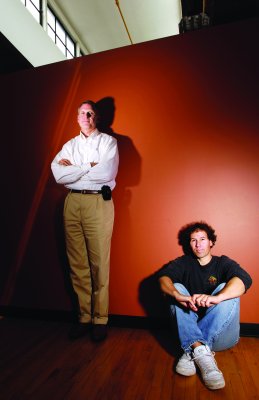They’re young, they’re creative and we’re guessing you’ve never heard of them. Meet some of the coolest startups running around Silicon Forest today.
They’re young, they’re creative and we’re guessing you’ve never heard of them. Meet some of the coolest startups running around Silicon Forest today.
STORIES BY ABRAHAM HYATT
PHOTOS BY MICHAEL G. HALLE
The simplest way to describe Toonlet is to compare it to digital paper dolls. Toonlet gives you a big pile of arms, bodies, faces, noses, ears, hairstyles, expressions, clothes, various accouterments and some empty comic strip panels. You, the user, pick and choose and resize those parts and then stick them together to form characters. Slap your finished web comic on your blog, email it to a friend or use it to respond to other user comics on the Toonlet site — the possibilities are as broad as your inner cartoonist’s dreams, regardless of its actual talent level. It turns out there are a lot of inner cartoonists out there: Since the site launched last December, 8,500 users have signed up. It’s received lots of praise on major tech sites and even got blogged about by USA Today. Schwartz and Ladygo didn’t set out to create an army of budding artists; they had backgrounds in programming and video game production and had raised seed money for a startup that would continue that work. But one day as Schwartz — a self-described non-artist — sat doodling, inspiration struck. “We were reading a lot of web and real comics and it just occurred to us that if people could make more comics, they could write fewer blogs,” Schwartz says. Their bevy of body parts-drawing artists has grown to include famed comics artist Peter Bagge and work submitted by users. Ultimately, Schwartz wants to see Toonlet become a sort of United Media, which syndicates major comic strips, for the everyday artist. But to do that they need cash. Currently the two founders are chasing down venture capital. Once that happens they’ll start looking at possible ways to expand. Merchandizing is one option; using those video game programming skills to create shapeable body parts could be another. “There’s a lot of places to take Toonlet,” Schwartz says. |
| 2. | WHO THEY ARE: Values of n WHAT THEY MAKE: I want Sandy WHERE THEY LIVE: Northeast Portland AGE: 2 years old NAME YOU SHOULD KNOW: Rael Dornfest, founder and CEO HOW TO FIND THEM: iwantsandy.com |
It’s not hard to anthropomorphize Sandy, the cheerful, free, web-based personal “assistant” launched by Dornfest last November. Her purpose is simple: keeping your calendar and to-do lists organized. But as the two of you communicate in natural language via email, text message, or Twitter — the social networking service that allows you to broadcast 140-character messages to people you choose — she starts to feel a little like the secretary you never had.
“Remind me on Friday to print out my plane ticket confirmation number,” you write her. Or, “Remind me about my meeting on Wednesday at 9 a.m.” She’ll send you a reminder at the correct time, or she’ll add events or contacts to your calendar program or address book. She even interfaces with Jott, the free service that turns phone calls into text messages or emails. One call to Sandy, via Jott, and moments later she’s adding something to your calendar.
Dornfest, previously CTO of Sebastopol, Calif.-based O’Reilly Media, recently went through a funding round (he declined to say how much was raised) with angel investors and says he’ll base future growth of I want Sandy on user need; adding subscription-based services is one option.
One thing he won’t change is Sandy’s personality. While Dornfest doesn’t reveal how many users I want Sandy has, he tells a story that’s indicative of her popularity: This last February some of her many fans emailed her Valentine’s Day greetings.
|
| ||||
JanRain is perhaps the leading developer in the growing world of OpenID, a service that lets you use a single ID to log in at multiple sites across the web. The issue of identity security has always been a big deal; different sites require different IDs, but each of those IDs are only as secure as the weakest place you use them. But if you’ve signed up at an OpenID hosting service like JanRain, the login process at any website — approximately 10,000 sites support OpenID logins — is conducted between JanRain and the site. All you have to do is enter a basic web address. And you can ratchet up the security as high as you want: JanRain users can get a phone call double checking their authenticity every time they log in to a site. The future, Kissel says, will be about data portability. Update your address at Expedia and when you use your OpenID to log into Avis to rent a car, it already knows the changes you made. Just don’t answer that identity-verifying call as you drive. |
| 4. | WHO THEY ARE: NuScale Power WHAT THEY DO: small-scale nuclear reactor development WHERE THEY LIVE: Corvallis AGE: 1 year old NAME YOU SHOULD KNOW: Paul Lorenzini, CEO
|
When Lorenzini says NuScale is developing a small nuclear reactor, he’s not kidding. He means “fits on a railroad car” small. He means 15-feet-by-60-feet small. True, that doesn’t take into account the other parts of a power plant, like a turbine and a generator. But compared to the multi-acre footprint of traditional nuclear power plants, this reactor design is tiny.
NuScale grew out of a federally funded study done by Oregon State University and other groups in 2000. Two years ago the university decided to commercialize the work and in 2007, via OSU’s tech transfer program, NuScale was born. The company went through its first funding round in January (Lorenzini declines to say how much was raised). The company is now focusing on marketing and the federal permitting process, which will take several years to prepare for and then complete.
So who’s in the market for a little nuclear power plant? People who need power but can’t access it, says Lorenzini. The NuScale plant puts out 45 megawatts — by comparison the now-demolished Trojan Nuclear plant produced 1,130 megawatts — which Lorenzini says makes a NuScale plant the perfect size for towns in extremely remote locations, or island nations, or industries that don’t want to rely on traditional power sources.
| 5. | WHO THEY ARE: WeoGeo WHAT THEY DO: Map-making services WHERE THEY LIVE: Portland State University AGE: 2 years old NAME YOU SHOULD KNOW: Paul Bissett, CEO and co-founder HOW TO FIND THEM: weogeo.com |
WeoGeo is undoubtedly the wonkiest startup on the list. And they’re also the newest to wear the “based in Portland” label. The company moved here from Florida earlier this year and now shares office space with other startups in PSU’s business accelerator. The company describes itself as a “one-stop marketplace for mapping.” But these aren’t maps for Sunday drivers. These are high-resolution, data-intensive maps used by scientists, surveyors and engineers. Users store, sell and buy data. That sounds simple until you see the server-busting size of these maps, which makes distribution, storage and even search functions very difficult.
Combining the searchable and selling aspects of geospatial data was a first, and one that Bissett says has been a big hit. The company, he says, hopes to create an eBay-like effect in the mapping community. But instead of used kitchen utensils, they’re helping sell the data that underlies everything from freeway construction to scientific research.
|
| ||||
| The loneliness of the small-business owner — Reimer knows it well. And as someone who has worked alongside other entrepreneurs as they develop their own companies, she knows another thing, too: The people who run small companies have more in common than they think — the same questions, the same concerns, the same desire for information that will let them know if they’re on the right path. Lumeno.us is like a CEO forum for the little guy. Users — who can remain as anonymous as they want — compare financial data with other users in the same industry or region or size of company. They can poll their peers on potential business decisions. They can, in the most non-buzzword sense of the word, network. Right now the site is in private beta, which means a few invited users are helping iron out wrinkles. One of the challenges, Reimer says, is providing enough tools but not swamping the busy small-business owner with too many bells and whistles. The site is expected to go public this fall.
|
| 7. | WHO THEY ARE: Iterasi WHAT THEY MAKE: Web page saver WHERE THEY LIVE: Downtown Vancouver AGE: 1 year old NAME YOU SHOULD KNOW: Pete Grillo, founder and CEO HOW TO FIND THEM: iterasi.com |
Find a cool web page online, click the bookmark function on your web browser and here’s what happens: Your browser remembers the location of that page. That’s it. Come back the next day and the page you’ve linked to — for example, a receipt for an online purchase or a form you’ve filled out — has changed. It’s called “dynamic content” — information that changes automatically as user information or a server database changes.
But with Iterasi, a simple browser-based tool, you can “freeze” a moment in time, saving a page in the exact state — complete with links and formatting — it was in when you visited. It’s a replica of a page instead of a remembered link. “We’re fanatics about the fidelity of the page,” Grillo says. Saved pages are searchable and shareable. Iterasi launched a private beta in February and will go public sometime this summer. Right now it’s only available for Windows users who use Internet Explorer and Firefox. According to Grillo, a version for Mac users will be available later this summer.
| 8. | WHO THEY ARE: LUNARR.com WHAT THEY MAKE: a collaboration platform WHERE THEY LIVE: Southwest Portland AGE: 2 years old NAMES YOU SHOULD KNOW: Toru Takasuka, founder and CEO; Hideshi Hamaguchi, co-founder and COO HOW TO FIND THEM: lunarr.com |
The phrase used again and again to describe LUNARR’s collaboration platform is “deceptively simple.” And the minute you start to play with the idea, you see why. Open up a Microsoft Word document filled with data from a group project you’re working on. Type some new info onto it. But wait, before you attach this thing to an email to send to a co-worker, click on the dog-eared corner in the upper right-hand corner. The document gracefully flips around.
On the back is an email field, other documents linked to this project, a place for notes, all previous revisions to the document — a tidy collection of everything associated with the “front” of the page. As Hamaguchi puts it, the front is for content; the back is for context. Takasuka, who was a tech entrepreneur superstar in Japan, and Hamaguchi, a long-time concept development guru at Matsushita (aka Panasonic), both had ties to the Portland area before starting LUNARR here in 2006.
Currently the platform is in private beta (which means it’s limited to a few invited users and still may see some changes) but will go public in the next few months. As Hamaguchi says, the moon is almost full.
| 9. | WHO THEY ARE: OsoEco WHAT THEY MAKE: A green social shopping network WHERE THEY LIVE: Downtown Eugene AGE: 1½ years old NAMES YOU SHOULD KNOW: co-founders Caroline Cummings, CEO, and Katie Wilson-Hamaker, president HOW TO FIND THEM: osoeco.com
|
“Web 2.0” is the now-ubiquitous term for websites and applications that allow users to interact and collaborate. Long ago the term degenerated into an overused buzzword, but it’s still around. Why? Because people keep coming up with great ways to interact online. Take OsoEco, for example, which describes itself as a sustainable social shopping community. OsoEco is targeting a type of shopper called social researchers — consumers who spend a significant amount of time learning from other online shoppers before purchasing something.
The company, which won $57,500 in the “sustainability track” of this year’s Angel Oregon contest, was originally slated to be an e-commerce site with an emphasis on educating businesses on sustainability. But the founders decided giving consumers the tools was a more powerful approach. Using interactive elements on the site and in their web browsers, users research and share information. “It takes the search out of research,” Cummings says. OsoEco had raised $110,000 by early June as part of a $1 million fundraising round. The site is expected to go public in November, just in time for the holiday shopping season.
| 10. | WEB STARTUPS |
OK, for No. 10 we’re going to cheat a little. Instead of focusing on one company, here are five young Portland-based web companies. All of them rank in the Top 26 of Techvibes.com’s monthly ranking of startups in Portland. (The Techvibes list averages the findings of two other companies, Alexa and Compete, which track web traffic at thousands of sites.) Maybe these guys aren’t the next eBay — which 71.6 million people visited in April, according to Compete — but they do offer another peek at the creative tech startups that dot Oregon’s business landscape.
| 1. | goneraw.com Gone Raw is the brainchild of Portland web designers Ray and Kandace Brigleb. They started the site in 2006 as a place for people to share and talk about raw and vegan food recipes. It’s proved to be a popular hangout: In April, a little under 30,000 visitors, according to web traffic tracker Compete, stopped by to be part of the conversation. |
| 2. | networthiq.com Created by the startup Fourio, networthiq.com blends social networking and personal finance. The site’s approximately 13,000 users track and compare their financial data. It’s part of a personal finance trend that has gotten the site mentioned everywhere from Business Week to the Wall Street Journal over the past year. |
| 3. | grabb.it The site calls itself “giant CD-eating rabbit.” We’ll call it an intriguingly simple way to play and search for web-based MP3 audio files (which are not stored on grabb.it). Users index and blog about their favorites, which they have a lot of: There are more than 10,000 musicians indexed on the site. |
| 4. | walkertracker.com They call themselves “pedometer enthusiasts,” and as of early June, they had counted, and blogged about, more than 2.1 billion steps at walkertraker.com. Author, web developer and site creator Ben Parzybok, who started the site in 2006 after receiving a pedometer as a gift, accounts for about 7.1 million of those steps. |
| 5. | urbandrinks.com This isn’t the biggest site — 1,000 to 3,000 visitors stop by each month according to Compete — but this list wouldn’t be complete without a Portland drinking site. Urbandrinks.com has a simple mission: track and find happy hours in your city; right now it’s limited to Portland, Seattle, Dallas and Columbus, OH. There are blogs and reviews and maps — even a way to punch in your address and find the nearest happy hour happening right now. It may not be miniature nuclear reactors, but it may be, to the Portland startup crowd looking for a way to unwind after another long day, just as significant. |
To comment, email [email protected].





